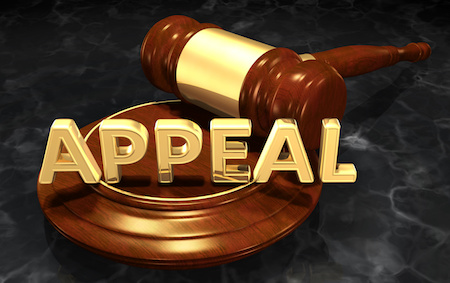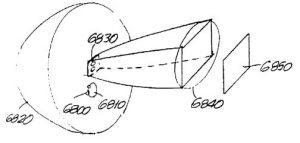 On September 22nd, a reply brief for appellant Cascades Projection LLC was filed to the U.S. Court of Appeals for the Federal Circuit in a case over the validity of patents covering projector technologies which were invented by Gene Dolgoff, the creator of the Star Trek Holodeck. The appeal against Japanese tech conglomerates Epson and Sony asks the Federal Circuit to decide whether the Patent Trial and Appeal Board (PTAB) erred in invalidating patent claims held by Cascades Projection and whether the PTAB acted in a manner which violated Cascade Projection’s right to due process under the U.S. Constitution.
On September 22nd, a reply brief for appellant Cascades Projection LLC was filed to the U.S. Court of Appeals for the Federal Circuit in a case over the validity of patents covering projector technologies which were invented by Gene Dolgoff, the creator of the Star Trek Holodeck. The appeal against Japanese tech conglomerates Epson and Sony asks the Federal Circuit to decide whether the Patent Trial and Appeal Board (PTAB) erred in invalidating patent claims held by Cascades Projection and whether the PTAB acted in a manner which violated Cascade Projection’s right to due process under the U.S. Constitution.
 The patent at issue in the case is U.S. Patent No. 7688347, titled High-Efficiency Display System Utilizing an Optical Element to Reshape Light with Color and Brightness Uniformity. Issued in March 2010, it claims a display system having a light source, an electronic-image forming element capable of having an image formed thereon, a light tunnel between the light source and the electronic-image forming element which has inner light-reflecting surfaces and an output aperture having an aspect ratio matching an aspect ratio of the image forming element. The invention address various shortcomings of conventional light projection systems such as difficulties in aligning cathode ray tube-based systems or inefficiencies in light valve projection systems.
The patent at issue in the case is U.S. Patent No. 7688347, titled High-Efficiency Display System Utilizing an Optical Element to Reshape Light with Color and Brightness Uniformity. Issued in March 2010, it claims a display system having a light source, an electronic-image forming element capable of having an image formed thereon, a light tunnel between the light source and the electronic-image forming element which has inner light-reflecting surfaces and an output aperture having an aspect ratio matching an aspect ratio of the image forming element. The invention address various shortcomings of conventional light projection systems such as difficulties in aligning cathode ray tube-based systems or inefficiencies in light valve projection systems.
Cascade Projection’s reply brief reiterates certain points from the firm’s opening brief filed with the Federal Circuit this June, including the argument that the PTAB improperly construed certain claims of the challenged patent. Those terms include “Fresnel polarizer,” “means for enhancing brightness” and “means for focusing.” For instance, Cascade Projections argues that the panel of administrative patent judges (APJs) deciding the case at the PTAB misidentified the term “input lens array” in a way which misconstrued “means for focusing.” The PTAB allegedly failed to understand the material difference between focusing light “into” a pixel and focusing light “onto” a pixel. Further, the PTAB erred in recognizing fundamental differences between lenses and prisms. “Therefore, the ‘way’ in which the focusing is achieved in the actual ‘347 Patent disclosure (namely through use of prisms) is different from the unsupported ‘way’ (i.e., use of lenses) implied by the claim construction ultimately adopted by the Board,” Cascade Projection’s opening brief reads. Cascade’s reply brief adds that the prism structure invented by Dolgoff directs light “onto” the pixel and a staple lens rather gathers the light which is directed “into” the pixel. “This is not complicated, and both the Board, and Appellees’ attempts to make it so are disingenuous,” Cascade argues, adding that it has presented conclusive evidence that the terms “pixel” and “pixel hole” are not synonymous, evidence which continues to be overlooked by the appellees and by the PTAB.
Cascade Projection’s reply brief also identifies what it argues are gross distortions to the facts regarding the meaning of “Fresnel polarizer,” mischaracterizations which are continued in a brief filed by appellee Epson and a brief filed by appellee Sony. These briefs repeat the “factually baseless claim” that prior to the invention covered by the ‘347 patent, the term “Fresnel polarizer” somehow had an established meaning among those of ordinary skill in the art and that the term could be construed by simply combining the terms “Fresnel lens” and “polarizer.” “In so doing, Epson and Sony go to great lengths to ignore what the ‘347 Patent says, what the technical dictionaries do not say, and what their own experts actually did say,” Cascade’s reply brief reads. At no point in the record did Epson or Sony identify a dictionary definition of “Fresnel polarizer” and even a Google search of the term doesn’t provide a definition, instead rendering results on polarizers, polarizer films and Fresnel rhombs. “Sony even admitted in its Petition that the term was ‘coined’ by Mr. Dolgoff,” Cascade’s reply brief reads. Cascade argues that correcting the erroneous claim construction is all that is required to resolve this part of the appeal in Cascade’s favor.
On top of the misconstrued terms, Cascade Projections argues that the PTAB improperly invalidated Claim 47 of the ‘347 patent in light of U.S. Patent No. 4912614 (“Goldenberg”), titled Light Valve Projection System with Non Imaging Optics for Illumination. The board invalidated Claim 47, which was only challenged by Sony, on the grounds that Goldenberg discloses either a “light tunnel” or the equivalent of one, despite the fact that it doesn’t appear that the term “light tunnel” even appears in the Goldenberg prior art. “These conclusions are a result of the Board’s wholesale and unfounded rejection of Mr. Bohannon’s unchallenged testimony that the structure disclosed by Goldenberg is not only substantially different from a light tunnel but would not even work in the actual world,” Cascade argues. Despite Sony’s argument that Cascade did not support its argument that the lamp and aluminum tube structure disclosed by Goldenberg, Cascade established that the electric arc lamp disclosed by Goldenberg would cause very high heat which would melt the aluminum tube, a point Cascade supported with expert testimony. “In short, the Board simply discounted Mr. Bohannon’s clear, direct testimony that the structure proposed by Goldenberg would not work in the actual world without receiving any evidence whatsoever to the contrary,” Cascade alleges in the reply brief.
Cascade Projections also briefed on an appeals issue regarding the effective filing date of the ‘347 patent, an issue presently pending at the U.S. Patent and Trademark Office, and constitutionality. Here, Cascade bears down on its objection to the violation of its own due process before the PTAB. Sony waived its challenge on this point but it remains an issue with Epson. “Agencies (such as the USPTO) lack jurisdiction to assess the constitutionality of their enabling enactments,” Cascade argues, noting that the issue of the PTAB’s constitutionality is something that the U.S. Supreme Court decided to take up by granting writ in Oil States Energy Services, LLC v. Greene’s Energy Group, LLC. Cascade alleges that, in the face of Epson’s arguments otherwise, it has proven that the PTAB lacks neutrality for two reasons. First, the same panel of APJs adjudicated both the institution decision as well as the final cancellation. That’s a regular practice at the PTAB but it’s one which former Chief Judge Paul Michel pointed out as flying in the face of the Congressional statute found in the America Invents Act (AIA) of 2011, the bill that created the PTAB. “This subjects the entire proceeding to the ‘anchoring’ bias,” Cascade argues. Further, Cascade argues that the jobs of those working at the PTAB depend on the work provided by petitioners. “A reasonable perception exists that the PTAB succumbs to financial incentives to bias outcomes for petitioners,” Cascade alleges. Together, these aspects of PTAB trials create a reasonable probability of bias which constitutes a violation of Cascade’s right to due process.
This focus on the due process violations caused by the PTAB in part stems from an opinion by Circuit Judge Pauline Newman who concurred in a decision by the Federal Circuit this May to deny a hearing en banc in Cascade’s case. “There is no doubt that a patent is a property right, with the attributes of personal property,” Judge Newman wrote:
“The question, then, is whether the statutory scheme created by the America Invents Act, in which the Office is given an enlarged opportunity to correct its errors in granting a patent, with its decision subject to review by the Federal Circuit, meets the constitutional requirements of due process in disposition of property.”
Though she concurred in the denial of the initial en banc hearing, Judge Newman acknowledged that uncertainties over due process rights at the PTAB existed and said that, if those issues remained unresolved after the panel decision in Cascade’s case, an en banc resolution would be appropriate at that time.

![[IPWatchdog Logo]](https://ipwatchdog.com/wp-content/themes/IPWatchdog%20-%202023/assets/images/temp/logo-small@2x.png)

![[[Advertisement]]](https://ipwatchdog.com/wp-content/uploads/2023/01/2021-Patent-Practice-on-Demand-1.png)
![[Advertisement]](https://ipwatchdog.com/wp-content/uploads/2024/04/Patent-Litigation-Masters-2024-sidebar-early-bird-ends-Apr-21-last-chance-700x500-1.jpg)

![[Advertisement]](https://ipwatchdog.com/wp-content/uploads/2021/12/WEBINAR-336-x-280-px.png)
![[Advertisement]](https://ipwatchdog.com/wp-content/uploads/2021/12/2021-Patent-Practice-on-Demand-recorded-Feb-2021-336-x-280.jpg)
![[Advertisement]](https://ipwatchdog.com/wp-content/uploads/2021/12/Ad-4-The-Invent-Patent-System™.png)







Join the Discussion
2 comments so far.
Perkins
October 12, 2017 12:42 pmHaving worked with large screen, high intensity projection systems for many years, I have to wonder if there was anybody on that particular panel of APJs who has the technical background to understand the technology and its components. Wasn’t having technical knowledge and skills (which are often not possessed by Article III courts) part of the reasons given for creating this entire USPTO/PTAB boondoggle in the first place? It certainly appears that this panel didn’t have such skills in this case, particularly when they substitute their faulty opinions for those of technical experts.
Night Writer
October 8, 2017 09:00 pmhttps://www.nytimes.com/2017/10/07/opinion/sunday/who-invented-zero.html?action=click&pgtype=Homepage&clickSource=story-heading&module=opinion-c-col-left-region®ion=opinion-c-col-left-region&WT.nav=opinion-c-col-left-region
OT, but has an interesting brief discussion about the difference between a discovery and creating something new. (Also, this should humble the goon squad to realize how long it took for this to happen. I can image the goon squad saying this is all per se obvious as they have no idea what hindsight reasoning is.)